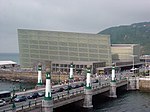Basilica of Saint Mary of the Chorus
18th-century Roman Catholic church buildings in SpainBaroque architecture in the Basque Country (autonomous community)Basilica churches in SpainChurches in the Basque Country (autonomous community)Roman Catholic churches completed in 1774 ... and 1 more
San Sebastián

The Basilica of Saint Mary of Coro (Basque: Koruko Andre Mariaren basilika, Spanish: Basílica de Nuestra Señora del Coro) is a baroque Roman Catholic parish church and minor basilica completed in 1774. It is located in the "Parte Vieja" (Old Town) of the city of San Sebastián, Gipuzkoa, Basque Country, Spain.
Excerpt from the Wikipedia article Basilica of Saint Mary of the Chorus (License: CC BY-SA 3.0, Authors, Images).Basilica of Saint Mary of the Chorus
Trinitate Plaza, San Sebastián Parte Zaharra - Parte Vieja (Erdialdea)
Geographical coordinates (GPS) Address External links Nearby Places Show on map
Geographical coordinates (GPS)
| Latitude | Longitude |
|---|---|
| N 43.323972222222 ° | E -1.9867222222222 ° |
Address
Santa Maria basilika
Trinitate Plaza
20003 San Sebastián, Parte Zaharra - Parte Vieja (Erdialdea)
Autonomous Community of the Basque Country, Spain
Open on Google Maps










